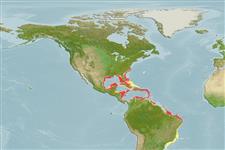Pallenopsis schmitti Hedgpeth, 1943
| Native range | All suitable habitat | Point map | Year 2050 |

|
| This map was computer-generated and has not yet been reviewed. |
| Pallenopsis schmitti AquaMaps Data sources: GBIF OBIS |
Upload your photos
Google image |
No photo available for this species.No drawings available for Phoxichilidiidae.
Google image |
No photo available for this species.
Classification / Names Common names | Synonyms | CoL | ITIS | WoRMS
Pycnogonida | Pantopoda | Phoxichilidiidae
Environment: milieu / climate zone / depth range / distribution range Ecology
Benthic; depth range 15 - 248 m (Ref. 116112). Tropical
Distribution Countries | FAO areas | Ecosystems | Occurrences | Introductions
Western Atlantic: Colombia, Caribbean Sea and Gulf of Mexico.
Length at first maturity / Size / Weight / Age
Maturity: Lm ? range ? - ? cm Max length : 1.0 cm TRKL male/unsexed; (Ref. 2115)
Short description Morphology
Large species with trunk length of almost 10 mm. Trunk fully segmented; lateral processes moderately short, separated by more than their diameters. Proboscis cylindrical, distally setose. Abdomen almost as long as chelifore scapes. Chelae large; palms inflated, very setose: fingers very short, carried synaxially. Palps represented by low, I-segmented knob. Ovigers robust, very setose; strigilis weak, with many plain spines. Legs long, with many long dorsal and lateral setae; ventral cement gland tube shorter than femoral diameter, on bulge at segment midlength. Propodus very short, slightly curved, with several large heel spines; claw moderately short; auxiliaries over half main claw length (Ref. 2115, p. 66).
Life cycle and mating behavior Maturity | Reproduction | Spawning | Eggs | Fecundity | Larvae
Members of the class Pycnogonida are gonochoric and sexually dimorphic. During copulation, male usually suspends itself beneath the female. Fertilization occurs as the eggs leave the female's ovigers. Males brood the egg masses until they hatch. Life cycle: Eggs hatch into protonymphon larva then to adults.
Main reference
References | Coordinator | Collaborators
Arango, C.P. 2002. (Ref. 1951)
IUCN Red List Status (Ref. 130435)
CITES status (Ref. 108899)
Not Evaluated
CMS (Ref. 116361)
Not Evaluated
Threat to humans
Human uses
| FishSource |
Tools
More information
Internet sources
BHL | BOLD Systems | CISTI | DiscoverLife | FAO(Publication : search) | Fishipedia | GenBank (genome, nucleotide) | GloBI | Gomexsi | Google Books | Google Scholar | Google | PubMed | Tree of Life | Wikipedia (Go, Search) | Zoological Record
Estimates based on models
Preferred temperature
(Ref. 115969): 21.1 - 27.6, mean 25.2 (based on 136 cells).
Price category
(Ref. 80766):
Unknown.


